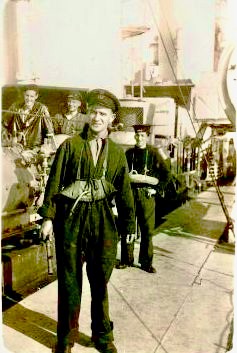Really? Half the Fun is Getting There?
N. Africa during Operation TORCH starting November 8, 1942
Perhaps 100 - 200 members of RCNVR/Combined Operations, some in their first action since undergoing initial training re the handling of landing crafts (e.g., at HMS Northney I - IV on Hayling Island, south coast of England), toiled on the shores of North Africa for about one-and-a-half weeks in mid-November, 1942. The work was exhausting (see previous entry here). On about November 20th, however, members of the Royal Navy took over their duties and - rejoice, rejoice! - the Canadians prepared to sail home.
Clean Beds Back in Liverpool are a Hop, Skip and Jump Away
After about one-and-a-half weeks completing 'ship to shore' duties at Z Beach east of Oran (in North Africa, during November, 1942), the Canadians in Combined Operations including my father Doug Harrison of Norwich, Ontario received a positive sign - a smoke signal of sorts - followed by word that their work was done and they would soon be returning to England's welcoming shores. Be still my beating heart!
Doug, oft-looking fondly at the Reina Del Pacifico resting at anchor a mile or two off shore from Arzeu amongst large supply ships, maybe the occasional destroyer and likely a bevy of spritely landing crafts, caught wind of something (as in 'something's up') near the end of the third week of November. The ship (a favourite to some), having served as a recovery centre for hungry and exhausted sailors for 10 - 11 days, was giving off a hint it was going to soon serve them in another way.
My father writes, "the dark green, two funnel Reina Del lay at anchor... and those two funnels were active enough to indicate steam was being brewed in the engine rooms." He mused (correctly), "She was as anxious as the sailors to head for home."
To get onto the ship, once official word was given, were the young sailors expected to climb up a thick hawser (braided rope) to reach the upper deck, that is, "hand over hand" (as Doug had done the first time he was sent to rest and recuperate onboard the ship)? No, not this time. Not much climbing really. More like a 'hop, skip and jump' according to my father's notes.
If not already on an LCA or LCM (landing craft, assault or landing craft, mechanised) the sailors hopped aboard a long and eager line-up of landing craft (now manned by members of the Royal Navy) heading off the beaches toward Reina Del Pacifico. These small craft (surely buoyed by good cheer) then skipped over the waves and joined others carrying Canadian sailors waiting their turn to enter the open hatch(es) of the waiting supply ship.
the far distance. Now imagine the Canadians jumping from moving landing
crafts up to the cargo doors... to go home! Photo - Imperial War Museum
"Our landing craft, one by one, manoeuvred to the gangplank on the port side of the Reina Del," my father writes.
And under the well-worn heading 'Getting There is Half the Fun' the Canadian sailors, 'one by one' as well, while surely feeling some pressure from the tricky situation they faced, had to time a perilous jump from a bobbing and weaving landing craft onto a narrow moving target. The sailors, loaded with some odds and ends of personal gear, waited "for the proper swell of the wave" before setting sail across an ever-changing gap of space onto a waiting gangplank.
You'd only get one go at this I'm thinking. Maybe wear a Mae West? Maybe two?
"Mae West" Life Belts, HMCS St. Laurent. Wearing a life belt, Chief
Ordnance Artificer Les Gill (foreground) stands near the torpedo tubes
of the destroyer HMCS St. Laurent. Photo - Canadian War Museum
When Dad's turn came he spotted something that he felt he needed to ask about, i.e., "a large unexploded shell imbedded in the side of the ship not far from the officer's head (Sub. Lt. Andrew Wedd)."
I can hear my father ask, "Isn't that shell going to be a problem?"
Wedd replied, "The Captain had the shell examined and it's a dud."
To that my father said (I think trying in his own way to show a bit of his sense of humour), "I sure hope he is right because my mother will miss me, Mr. Wedd."
"Your mother will miss you a lot more if you're not on board on the next swell, Harrison, because we are leaving," snapped the Sub. Lt. "Do you hear me?" (He added a bit more which couldn't be printed.)
Wedd's ultimatum focussed my father's mind (Okay, I guess it's no time for jokes!) and he timed the next swell perfectly.
"I jumped to the gangplank, and though tired, I found new energy at the cargo door and was soon amidship." He also added that the shell never exploded "but it was sand-bagged and roped off."
As for Dad's mates, if they landed safely (and no notes were shared about any fellows falling into the Mediterranean Sea) they rushed up the exterior steps and boarded via the same cargo door.
"Each one was checked off by name by another Canadian officer standing inside... complete with clip-board."
The Reina Del's anchor was soon clanking "in the hawse pipe, the gangplank was soon stowed" and in a few hours the friendly ship was "steaming at 27 knots (about 33 mph)" toward the submarine nets at Gibraltar.
An anti-submarine net used during World War II in Nova Scotia, Canada
Photo Credit - Anti-submarine net, Wikipedia
More FAINT FOOTSTEPS, World War II will soon follow.
Please click here to view Editor's Column: FAINT FOOTSTEPS, World War II (14)
Unattributed Photos GH
Please click here to view Editor's Column: FAINT FOOTSTEPS, World War II (14)
Unattributed Photos GH




No comments:
Post a Comment